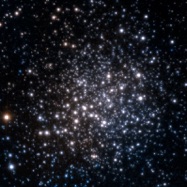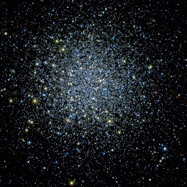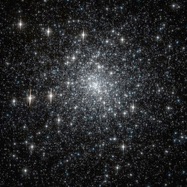






Cosmic-Lab
Star Clusters as Cosmic Laboratories for Astrophysics, Dynamics and Fundamental Physics

Globular Clusters (GCs) are the most populous, old and dense stellar clusters in the Galaxy: they are aggregates of a million stars whose distance, age and chemical composition can be determined with great accuracy. Their study addresses fundamental astrophysical questions, ranging from the formation of the Galaxy and the first stars, to stellar evolution and dynamics.
With Cosmic-Lab we intend to use these natural laboratories to perform three original experiments which will have a major impact in several areas of the modern Astrophysics and Physics research. To this aim we intend to use as test particles three fascinating classes of "exotica": blue straggler stars (BSS), millisecond pulsars (MSPs) and intermediate-mass black holes (IMBHs).
Experiment 1 - Probing the nature of BSS: toward the definition of a "dynamical clock" for stellar systems.
We intend to exploit the observed properties of BSS for defining an innovative tool able to measure the degree of dynamical evolution of a stellar system. This is a crucial ingredient for understanding the past and future history of collisional systems and the formation processes of non-canonical objects which can be at the origin of the mysterious UV emission from remote galaxies.
Experiment 2 - Hunting for the most massive neutron stars: probing the equation of state of matter at the nuclear equilibrium density.
GCs are known to be very efficient furnaces for the formation of MSPs. We plan to extensively search for the companion stars to binary MSPs in Galactic GCs, thus exploiting the unique opportunity offered by these systems of measuring the neutron star mass. This will finally allow us to determine the upper limit for the mass of these compact objects and tightly constrain the (still unknown) equation of state of matter at the nuclear equilibrium density, thus opening a new window in the domain of the Fundamental Physics research.
Experiment 3 - Unveiling the existence of IMBHs: the missing link in the formation of cosmic structures.
Given the increasing evidences that Galactic GCs which appear "normal", may instead hide an IMBH in their centre, we plan to use a set of non-conventional data-analysis procedures developed by our group in order to robustly unveil the IMBH fingerprints. Proving the existence of these objects is crucial for understanding
the formation of super-massive BHs, which are observed at the centre of all massive galaxies at any redshift, with a major impact on the comprehension of the formation and evolution of cosmic structures.
The project is carried out through a tight synergy among (i) top-quality photometric and spectroscopic data obtained at the most powerful ground-based telescopes (VLT, LBT, Keck) and space facilities (HST, GALEX), (ii) the application of innovative, non-conventional data-analysis techniques and (iii) a new generation of theoretical models and dynamical simulations.